![]()
![]()
![]()
Use LEFT and RIGHT arrow keys to navigate between flashcards;
Use UP and DOWN arrow keys to flip the card;
H to show hint;
A reads text to speech;
77 Cards in this Set
- Front
- Back
- 3rd side (hint)
|
VCC |
Imp for installation, servicing and troubleshooting |
|
|
|
Two refrigeration cycles |
Vapour compression cycle and Absorbtion cycle |
|
|
|
Absorption cycle |
Specialized fields - large buildings and recreational vehicles use absorption cycle |
|
|
|
Pressure enthalpy (PE) charts |
Show the characteristics of refrigerants Shows various refrigerant conditions throughout the operating region system: as liquid , vapour and as saturated |
|
|
|
Vapour |
Form of gas that easily converts to to vapours. Vapours exist below the critical point for all refrigerants |
|
|
|
The critical point |
On a PE chart is a specific temp and pressure relationship for each refrigerant Above critical point a gas cannot be liquified and a liquid cannot be changed into a gas. Refrigerant become unpredictable above the critical point. |
|
|
|
Below the critical point |
Refrigerant gases are called vapours |
|
|
|
Vapour compression |
Squeezing action that attempts to make something smaller 1. Positive displacement 2. Centrifugal compression |
|
|
|
Positive displacement |
Process using a moving piston to squeeze vapour in a cylinder. Piston rings seal the vapours in cylinder |
|
|
|
Reciprocating compressor |
Positive displacement compressor Vapour compression occurs, when the piston positively displaces any vapour within the cylinder |
|
|
|
Centrifugal compression |
Non- positive displacement compressor with a radial wheel that moves vapours. Non positive displacement compressors has no cylinders or pistons They has impeller wheels inside a chamber called a volute. |
|
|
|
Centrifugal compressor |
The increase in velocity of the refrigerant vapour passing through a centrifugal compressor increases the pressure of the refrigerant. |
|
|
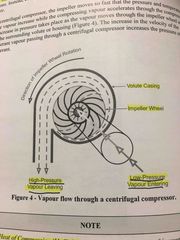
Front (Term) |
Vapour flow centrifugal compressor |
|
|
|
Heat of compression ( HoC) |
Heat energy added to refrigerant vapour by the work of compressor. The amount of pressure increases with a compressor relates directly to the amount of heat produced during compression |
|
|
|
Heat of compression ( HoC) |
Heat energy added to refrigerant vapour by the work of compressor. The amount of pressure increases with a compressor relates directly to the amount of heat produced during compression |
|
|
|
HoC |
The higher the HoC, the lower the refrigeration systems efficiency, or Coefficient of Performance (CoP) |
|
|
|
Heat of compression ( HoC) |
Heat energy added to refrigerant vapour by the work of compressor. The amount of pressure increases with a compressor relates directly to the amount of heat produced during compression |
|
|
|
HoC |
The higher the HoC, the lower the refrigeration systems efficiency, or Coefficient of Performance (CoP) |
|
|
|
Coefficient of Performance (CoP) |
Coefficient of Performance (CoP) is the amount of heat gain in the evaporator divided by the HoC |
|
|
|
Stages of the Vapour Compression Refrigeration Cycle |

Back (Definition) |
|
|
|
Refrigeration Cycle |
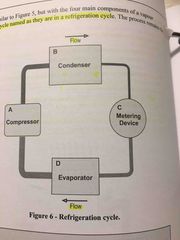
Back (Definition) |
|
|
|
In a perfect refrigeration system, how much does the pressure change in the high (condenser) side of the refrigeration system? |
0% |
|
|
|
Refrigeration system components |
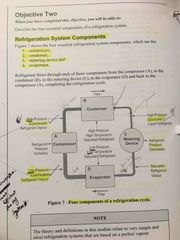
Back (Definition) |
|
|
|
Five compressor types |
Positive displacement compressor 1. Reciprocating 2. Rotary ( stationary and rotating blade type) Rotating blade are number one vacuum pump. 3. Scroll - In AC industry and now in oil and gas. One of the most efficient. Must turn in one direction. 4. Screw- lateral space compression. ( twin flooded, single flooded and twin dry) |

|
|
|
Five compressor types |
Positive displacement compressor 1. Reciprocating 2. Rotary ( stationary and rotating blade type) Rotating blade are number one vacuum pump. 3. Scroll - In AC industry and now in oil and gas. One of the most efficient. Must turn in one direction. 4. Screw- lateral space compression. ( twin flooded, single flooded and twin dry) |
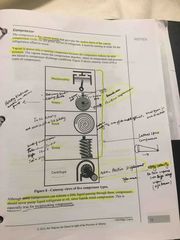
|
|
|
Non- positive displacement |
Cetrifugal Use velocity to turn vapours into high velocity vapours. ( High pressure) |
|
|
|
Compressor liquid tolerance |
Some compressor can tolerate a little liquid passing through them. Compressors should never pump liquid refrigerant or oil, since liquids resist compression. This is especially true for reciprocating compressors |
|
|
|
Types of reciprocating compressors |
Hermetic - resiprocating Semihermatic - reciprocating Open |
|
|
|
Condenser |
HPHT vapours entering the condenser continues to lose heat throughout the first pass or two of the condenser. |
|
|
|
Deauperheating |
The initial heat loss is called desuperheating |
|
|
|
Phase change in condenser |
After initial heat loss in condenser, refrigerant begins a phase change by starting to condenser into a liquid. |
|
|
|
Phase change in condenser |
After initial heat loss in condenser, refrigerant begins a phase change by starting to condenser into a liquid. |
|
|
|
Saturated pressure in condenser |
Saturated pressure in condenser sets a constant pressure throughout the high pressure side of the vapour compression cycle. The condenser gives off heat while condensing the refrigerant and sub cooling the liquid refrigerant that collect near the end of the refrigerant’s flow through the condenser. |
|
|
|
Subcooling |
The liquid remains at the condensing pressure to the end of the condenser, but just before leaving the condenser, the temp of the liquid drops. When liquid’s temp drops while its saturated pressure remains, it is known as subcooling. Once the ref vapour turned to liquid, the ref leaves the condenser. |
|
|
|
Metering device |
Is a pressure reducer. Metering device receives liquid red from the condensing unit. No vapour should enter the metering device. High pressure sub-cooled liquid pass through the metering device( metering or control point) - expansion of the refrigerant takes place and pressure dropped to low side or evaporator pressure. |
|
|
|
Metering device |
Is a pressure reducer. Metering device receives liquid ref from the condensing unit. No vapour should enter the metering device. High pressure sub-cooled liquid pass through the metering device( metering or control point) - expansion of the refrigerant takes place and pressure dropped to low side or evaporator pressure. |
|
|

Front (Term) |
Capillary tube Automatic expansion valve Small thermostatic expansion valve Large thermostatic expansion valve ( TX valve) |
|
|
|
Boiling |
Process of adding heat to a liquid at atm pressure |
|
|
|
Refrigeration |
Process of moving heat by means of evaporation or expansion. It takes heat away from air, water or brines and move the heat to a refrigerant, Usually at a pressure below atmospheric ( in a vacuum) |
|
|
|
Refrigeration |
Refrigeration utilizes low boing points, but you should use the term boiling only with hot water or steam heating systems. |
|
|
|
Evaporator |
Is a heat exchanger that draws heat into vapour compression cycle. LTLP vapours enters into evaporator and draws heat from surrounding and coverts into HPHT bubbling vapours. Rate of vapour leaving the evaporator changes only if the compressor’s pumping rate or its capacity changes. Running compressor refuses the vapour pressure above the saturated mixture of liquid and vapour ref. The reduction in vapour reaches the desired saturation point and maintains a steady flow of refrigerant vapour out of evaporator |
|
|
|
Energy |
Ability or capacity to do work. Potential energy Kinetic energy |
|
|
|
Latent Heat |
The heat added or removed to cause state change is called latent heat. It is a hidden heat cause state change. |
|
|
|
Latent Heat |
The heat added or removed to cause state change is called latent heat. It is a hidden heat cause state change. |
|
|
|
Sensible heat |
Causes a change in temp. Sensible heat is important in refrigeration when liquids are Subcooled or vapours are superheated. |
|
|
|
Saturation |
Is a condition in which one substance holds as much as it can of a different substance. |
|
|
|
Saturation |
Is a condition in which one substance holds as much as it can of a different substance. |
|
|
|
Saturation point |
Is a condition in which one substance has reached 100% saturation with a second substance, or with a different phase of the same substance.
The different phase of the same substance is a critical component of the refrigeration cycle. |
|
|
|
Pressure and saturation point |
When you raise the pressure of water, you also raise the saturation point or boiling point. |
|
|
|
Two saturation points in refrigeration cycle |
One at low pressure and one at High pressure. First saturation point during evaporation process in evaporator. A Pressure temp chart helps to find the corresponding pressure to maintain the temp. |
|
|
|
Law of thermodynamics |
1. Energy cannot be created or destroyed. Also called law of conservation of energy. 2. Energy moves or transfer from high energy position to low energy position. |
|
|
|
Second saturation point |
In condenser.Each condensing pressure corresponds to one condensing temp. Both first and second saturation points are used for refrigeration design and troubleshooting. Saturation points are valuable troubleshooting data and are a major feature of your work as ref mechanic. |
|
|
|
Superheating |
Is the process of adding sensible heat to the vapour of a substance while that substance remains at the same pressure. When the temp of a vapour is raised above its boiling point( while at the boiling pressure), the sensible heat added is caked superheat. |
|
|
|
Superheating |
Is the process of adding sensible heat to the vapour of a substance while that substance remains at the same pressure. When the temp of a vapour is raised above its boiling point( while at the boiling pressure), the sensible heat added is caked superheat. |
|
|
|
Negative implication of superheat |
Negative implication of superheat is the increase in vapour volume as the superheat increases. A higher vapour volume means a reduction in amount of refrigerant the compressor is able to pump. |
|
|
|
Subcooling |
Subcooling takes place in a liquid when it’s temp is lowered below its boiling point. An increase in subcooling of liquid refrigerant means a reduction in sensible heat in the refrigerant. A decrease in sensible heat means a reduction in the amount of heat contained by the refrigerant. A lower amount of heat, or enthalpy, results in increased capacity in the cooling section. |
|
|
|
Subcooling |
Too much Subcooling ~ too much refrigerate in lines after condenser => system malfunction Too less subcooling - bubbles going to metering device |
|
|
|
Stages of Refrigeration cycle |
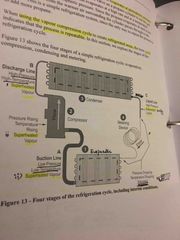
Back (Definition) |
|
|
|
Stages of Refrigeration cycle |
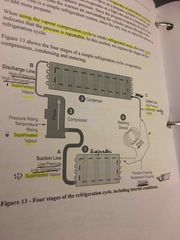
Back (Definition) |
|
|
|
Stages of Refrigeration cycle |
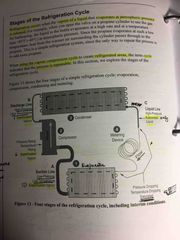
Back (Definition) |
|
|
|
Stages of Refrigeration cycle |
2 super heated vapours One vapour is LPLT superheated vapour Second is HPHT superheated vapour 1- subcooled liquid ( High Pressure) |
|
|
|
Evaporation |
Evaporator absorb heat from cooling air or brine Evaporator receive its supply of saturated liquid refrigerant from the metering device. Evaporator has refrigerant mixture of low pressure, low temp, saturated liquid and vapour. The refrigerant mixture is mostly liquid at the begging of evaporating state, half liquid half vapour in middle and complete vapour at the end of evaporating stage. |
|
|
|
Evaporation |

Back (Definition) |
|
|
|
Metering device |
Metering device feeds saturated liquid to evaporator |
|
|
|
Compression |
Compressor receive low pressure vapour refrigerant from the evaporator Adds more superheat to the refrigerant vapour |
|
|
|
Desuperheating |
Takes place when sensible heat leaves the vapour, but not at the rate high enough to reduce the vapour’s temp to the saturation point. The final desuperheating should not take place until the refrigerant is in the condensing stage. |
|
|
|
Compressor flow |
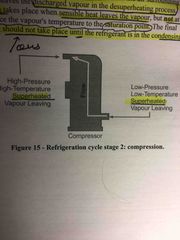
Back (Definition) |
|
|
|
Compressor flow |
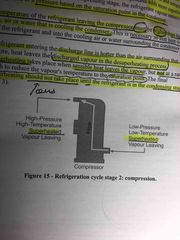
Back (Definition) |
|
|
|
Condensing |
Desuperheating that started in discharge line. Once ref vapour reaches saturation point within the confines of a condenser, it begins to condense into liquid refrigerant. At this point we have a predictable pressure and temperature. The pressure is called condensing pressure and is same from the outlet of the compressor to the inlet of metering device. |
|
|
|
Condenser |
Last areas of the condenser, entire refrigerant is liquid. The liquid ref continues to lose heat to the surrounding media, so it becomes subcooled. Subcooling continues as the refrigerant leaves the condenser and enters the liquid line. |
|
|
|
Subcooling two major purposes |
1. Increase in refrigerant’s ability to absorb heat later in the evaporator; the lower the temp the more it can attract heat. 2. Formation of a liquid seal at the entrance of the metering stage. Which make sure no vapour enter the metering device. |
|
|
|
Condensing |
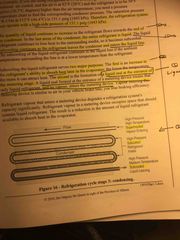
Back (Definition) |
|
|
|
Metering device |
Metering device is a restriction or orifice that reduce the refrigerant pressure from condensing pressure to evaporating pressure. If the office is too small, then evaporator strayed of refrigerant, if it is too large then evaporator floods with liquid refrigerant that can spill into suction line and damage the compressor. Liquid line delivers the liquid refrigerant to the metering device. Metering device used is based on the application and size of refrigeration unit. |
|
|
|
Capillary tube or cap tube |
Small refrigeration systems, such as refrigerators, small ice machines and window air conditioners have simple metering device called capillary tube or cap tube |
|
|
|
Capillary tube or cap tube |
Cap tube must be sized to exactly match the capacity of the system. |
|
|
|
Flash gas |
Once the refrigerant’s pressure drops due to passing through the metering device,s orifice, some of the refrigerant flashes or becomes a vapour. This vapour is called flash gas. The flash gas is at a very low temp because it experience a drastic reduction in pressure. Flash gas cools the rest of the liquid refrigerant, which is now moving towards the entrance of the evaporator. |
|
|
|
Capillary tube or cap tube |
When high pressure subcooled liquid refrigerant enters the cap tube, the pressure drops due to the friction produced by the narrow cap tube passage being applied to liquid refrigerant. Toward the far end of the entering point of the capillary tube the refrigerant pressure drops below the saturation point and it begins to evaporate. |
|

